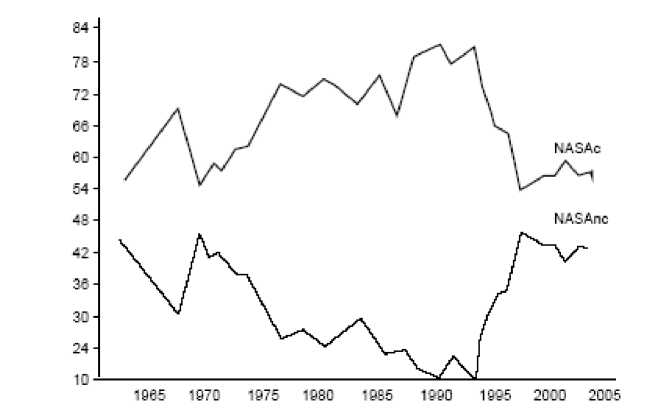226
Journal of Applied Economics
Table 1. Description of time series variables
Variable Description
CPAF Cost plus award fee contracts (percentage of the total value of contracts awarded
by NASA)
CPFF Cost plus fixed fee contracts (percentage of the total value of contracts awarded
by NASA)
FFP Firm fixed price contracts (percentage of the total value of contracts awarded by
NASA)
INC Incentive contracts (percentage of the total value of contracts awarded by NASA)
NASAc Value of NASA competitive contracts as a percentage of the total value awarded;
NASAnc Value of NASA non-competitive contracts as a percentage of the total value
awarded.
NASA Contracted value to the top 10 firms as a percentage of the total appropriations
top10 made by NASA
SENASA Space appropriations made by NASA at constant 1999 prices
Note: the inclusion of the letter “L” prior to all variables denotes the log of the respective time
series (i.e., LCPAF: log of CPAF). All figures are annual.
Figure 1. Competition in NASA contracts as a percentage
of total contracts awarded

Note: NASAc: the value of the NASA competitive contracts as a percentage of the total
value awarded; NASAnc: the value of the NASA non-competitive contracts as a percentage
of the total value awarded. Data sources: NASA (1983) to (2004a).
More intriguing information
1. The name is absent2. Job quality and labour market performance
3. BEN CHOI & YANBING CHEN
4. Visual Perception of Humanoid Movement
5. Estimating the Economic Value of Specific Characteristics Associated with Angus Bulls Sold at Auction
6. CONSUMER PERCEPTION ON ALTERNATIVE POULTRY
7. The name is absent
8. LAND-USE EVALUATION OF KOCAELI UNIVERSITY MAIN CAMPUS AREA
9. The Shepherd Sinfonia
10. Empirically Analyzing the Impacts of U.S. Export Credit Programs on U.S. Agricultural Export Competitiveness